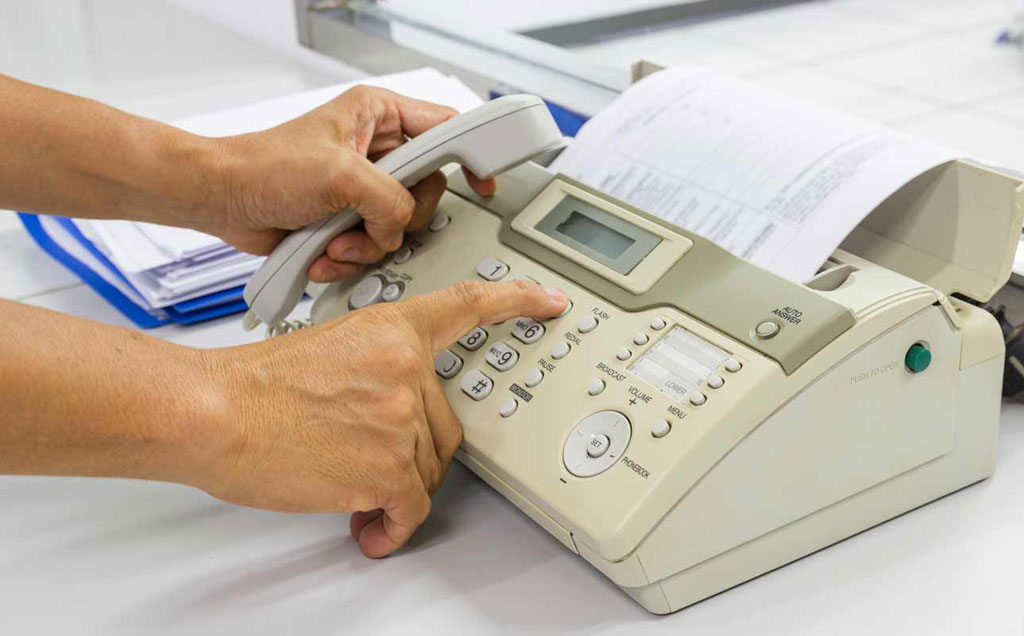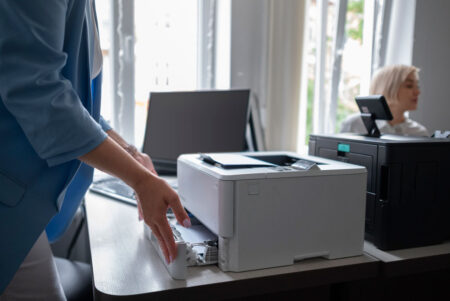Fax machines are often considered outdated, but do they still have a place in the business world?
Faxing might seem like an archaic practice now that email and other digital means of communication dominate the business landscape. However, it turns out that faxing is alive and well today. That’s because a fax is often viewed as a more secure form of transmitting a document. Further, some regions and government agencies still require a physical signature on various forms, which demands a facsimile of a signed document to be sent over.
While faxing is still a common way to transmit a document, whether a fax machine is still useful sort of depends on your industry. For the most part, if you have a cell phone, you have a fax solution that’s cheaper, faster and easier to use than a large, cumbersome fax machine. While fax machines are a common sight in courthouses and hospitals, you wouldn’t necessarily see a private attorney using one.
Other businesses may still use fax machines or online fax services to send documents because they don’t trust the security of email, while some just prefer using the technology they’re already familiar with. Some people may have a fax machine and not even know it, as many popular multifunction printers for a home or small office have one built in. New fax machines usually use the latest tech to make sure they’re viable solutions, but unless your job specifically demands one, they’re not exactly essential anymore.
Editor’s note: Looking for the right digital copier for your business? Fill out the below questionnaire to have our vendor partners contact you about your needs.
A brief history of the fax machine
The first fax machine was designed by Scottish inventor Alexander Bain, who patented his “electric printing telegraph” on May 27, 1843, and naturally went on to reproduce the first graphic signs in 1846. English physicist Frederick Bakewell refined Bain’s original design to create a telefax machine in 1851, which he demonstrated at the World’s Fair in London.
Things started getting interesting in 1865, when Italian physicist Giovanni Caselli invented the pantelegraph. The pantelegraph technology is particularly noteworthy because Caselli used it to create the first commercial telefax service between Paris and Lyon, over a decade before telephones were created.
Around 1900, the bildtelegraph (aka image telegraph) was developed by German physicist Arthur Korn, who specialized in electrical engineering and quantum mechanics. The bildtelegraph was widely used throughout continental Europe, most notably when a photo of a wanted criminal was sent from Paris to London in 1908. It continued to be popular until the advent of radiofax.
Invented in 1924 by American engineer Richard H. Ranger, the wireless photoradiogram (aka radiofax) was used to send a photograph of U.S. President Calvin Coolidge from New York to London through transoceanic radio facsimile. By 1926, radiofax was a commercially available service, and in the late 1930s, “radio newspapers” were being transmitted directly to subscribers using an AM radio and a printer.
In the 1960s, Xerox introduced the long-distance xerography (LDX) machine, which was built as a smaller solution to fax and copy machines that used telephone transmissions to transfer a letter-sized document in less than six minutes. Businesses started adopting fax machines on a much greater scale in the 1970s, and with so much competition creating new innovations, that’s when most of the features, like optical scanning and fast transmission, were introduced.
Did you know? Faxing traces its roots back to the mid-1800s, when Giovanni Caselli created the first telefax service between Paris and Lyon.
Alternatives to fax machines
As internet technology became more sophisticated in the early 2000s, businesses started phasing out fax machines because of their cost, size and maintenance requirements. That’s when email became a popular method of sending documents.
Whether one needed to send a document, image, PDF or any other type of file, emailing an attachment was an easy option. But when an official signature was necessary, emails didn’t offer the security and verification a notary would require. Courier services and physical mail were still popular options for sending legal documents, but they were very slow.
Scanning documents and emailing the PDFs is another method that became popular because it combined the best of snail mail and email, allowing you to capture a physical document and send it out in seconds. This method remains in use today, but instead of scanning a document, people typically just take a picture of it with their cell phone camera and send the image to whoever needs it.
In June of 2000, the E-Sign Act passed, giving electronic signatures the same legal status as handwritten signatures throughout the U.S. This paved the way for e-fax services like RingCentral Fax and e-signature services like DocuSign, eliminating the need for a dedicated fax machine within the average office. You can now handle all of your faxing needs from a PC, or even your mobile device.
To answer the question “are fax machines obsolete?” in one word – yes. However, the practice of faxing documents is alive and well. As long as businesses want the additional security of faxing the sensitive legal or financial documents they send and receive, online faxing will remain a viable option. How it is done, however, is evolving.
Did you know? Electronic signatures carry the same legal weight as handwritten signatures, so legally binding documents that use e-signing tools are valid.
What should I do with my old fax machine?
With proper maintenance, the average fax machine can last up to 10 years, though it doesn’t hold its value well. Like most technologies, fax machines depreciate quickly, but after a decade of use, this is understandable. While it’s easy enough to sell a used fax machine, it’s usually not advisable. You probably won’t get much for it, and a lot of precautions are necessary.
A fax machine operates by storing an image of every single fax page it receives. Older versions would store that information on a thermal print cartridge roll, while modern fax machines store the data on a hard drive. Either way, sensitive information is stored in the fax machine, and if you don’t properly dispose of it, you could leave yourself open to massive security breaches and identity theft.
Several services can help you correctly dispose of an old fax machine so your data stays safe and secure. Legal Shred, for example, offers an industrial shredding service to completely destroy your old fax machine and, more importantly, the sensitive data inside. These services also recover all recyclable materials and properly dispose of toxic materials.
FYI: You must properly dispose of your old fax machine when transitioning to online faxing and electronic signatures, which usually means hiring a professional service like Legal Shred. Many components are recyclable, and others could cause pollution if not properly handled.



